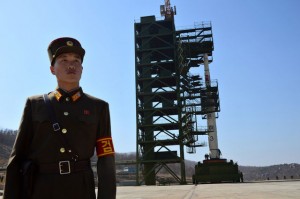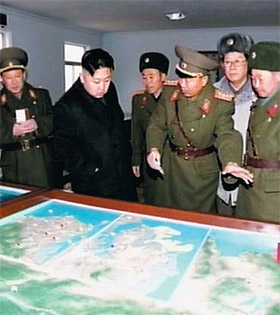The Unveiling of North Korea’s ICBM

North Korea’s planned satellite launch has been widely condemned on the grounds that there is little difference between a space launcher and a missile. US government spokesmen have declared that firing off a long-range rocket, regardless of payload, will violate the terms of the missile-test moratorium included in the February 29 understanding between Washington and Pyongyang (the so-called Leap Day Agreement). This claim has obscured what ought to be the more significant development: the gradual unveiling of an actual North Korean inter-continental ballistic (ICBM) missile force. A space launcher could be considered dual-purpose; an ICBM cannot.
Over the past year’s time, little-noticed public statements by American officials and a series of oblique references in the North Korean state media have telegraphed the appearance of the new weapon system. Regardless, in the absence of a flight test, a televised display, or a statement by American officials judging the missile to have been deployed, the emerging ICBM force has yet to enter the public consciousness.
Certainly, North Korea’s progress comes as a surprise, even to those who track these matters closely. The decisions of about a decade ago to withdraw from the Anti-Ballistic Missile (ABM) Treaty and to deploy the Ground-based Midcourse Defense System were premised on the eventual emergence of North Korean (and Iranian) ICBMs. But even as late as March 2009, just prior to North Korea’s last space-launch attempt, then-Secretary of Defense Robert Gates was still downplaying Pyongyang’s ability to build weapons that can hurdle the Pacific.
Calling the upcoming rocket launch “a mask for the development of an intercontinental ballistic missile,” Gates told Chris Wallace of Fox News that fielding nuclear-armed missiles was North Korea’s “long-term intent,” not a near-term prospect.
The February 2010 report of the US Department of Defense’s Ballistic Missile Defense Review took a similar view, treating North Korean ICBM development as somewhat uncertain in its progress. “Although the test launches of the TD-2 [Taepodong-2] in 2006 and 2009 were deemed unsuccessful,” the report concluded, “we must assume that sooner or later North Korea will have a successful test of its TD-2 and, if there are no major changes in its national security strategy in the next decade, it will be able to mate a nuclear warhead to a proven delivery system.”
Before the end of the year, something changed minds at the Pentagon. During an overseas trip that November, Gates told the press that North Korea was “clearly developing longer range missiles, including potentially a mobile ICBM,” a claim not heard before. In Beijing the following January, Gates explained that he had just warned the Chinese leadership that North Korea was “becoming a direct threat to the United States” on account of its development of nuclear weapons and ICBMs. While not “immediate,” he said, the threat would emerge in less than five years.
Gates restated his concern about “potentially a road-mobile” ICBM in North Korea during a June 2011 policy conference in Singapore. He added that President Barack Obama had raised the issue with Chinese President Hu Jintao in the fall of 2010—perhaps just prior to a meeting of the G-20 in Seoul in November.
A few weeks later, Gates made his last observations on the subject, telling John Barry of Newsweek, “North Korea now constitutes a direct threat to the United States. The president told [China’s] President Hu that last year. They are developing a road-mobile ICBM. I never would have dreamed they would go to a road-mobile before testing a static ICBM. It’s a huge problem. As we’ve found out in a lot of places, finding mobile missiles is very tough.”
This March, Gates’s comments were echoed in the testimony of Admiral Robert Willard of US Pacific Command before the House Armed Services Committee. Willard described the emerging missile’s mobility as making it “less predictable than Taepodong-2 or some of the other ballistic missile capabilities that are a little more easy to observe.”
In its own unique way, the North Korean government has also started publicizing the new weapon system. Starting in February 2011, the Korean Central News Agency (KCNA)—North Korea’s official, externally-oriented news service—started issuing frequent reports on the modernization activities of Russia’s ICBM force, the Strategic Rocket Force (SRF), and its Chinese counterpart, the Second Artillery. Ten such reports appeared in 2011, and another six in just the first three months of 2012. All but three of these stories have concerned the SRF. For example:
- “Russia Strives to Strengthen Strategic Rocket Forces”
- “Russia Plans to Equip Its Strategic Rocket Force with New-type Missiles”
- “Russia Will Take Resolute Measures against US Missile Defence.”
- “Russia Launches ICBM”
- “Russian Strategic Rocket Forces Start Combat Patrol”
Without saying a word about North Korea, these reports portray the development and deployment of new ICBMs as legitimate and necessary in the face of the American threat. They do not appear accidentally: KCNA’s online archive, which extends back to January 1997, contains just one previous reference to the SRF, in December 2003. The archive contains no earlier mentions of the Second Artillery.
The first hint at North Korea’s own achievements in the ICBM field came just days before the announcement of the Leap Day Agreement. A February 25 statement attributed to the National Defense Commission—North Korea’s most authoritative public voice—condemned upcoming joint US-South Korean exercises. By itself, there was nothing unusual in such a declaration, except for one detail. It contained, for the first time, an explicit warning of North Korea’s ability to attack the United States:
The US is sadly mistaken if it thinks it is safe as its mainland is far away across the ocean…There is no limit to the striking intensity and range of our army and people to wipe out the aggressors.

By this time, too, a South Korean newspaper, Chosun Ilbo, had already reported that North Korea’s new leader, Kim Jong Un, had visited the North Korean military organization responsible for nuclear weapons and missiles. Another article profiled its chain of command.
The North Korean media issued a similar message itself on March 2 by announcing that Kim Jong Un—accompanied as usual by senior military and party officials—had inspected “the Strategic Rocket Force Command” of the Korean People’s Army. Still photos from the tour were broadcast on national television.
No such organization seems to have appeared in the North Korean media before, despite the claim that the facility had been visited by Kim Jong Un’s two predecessors. It may be synonymous with the Artillery Guidance Bureau—the name by which the organization commanding North Korea’s missile force has been called in the South Korean media. Publicizing the body for the first time under the name “Strategic Rocket Force Command” signals that Russia’s mobile missile force has become the implicit role model for North Korea’s.
Less apparent is exactly what developments have given both Washington and Pyongyang confidence that North Korea is making progress toward deploying an ICBM. In November 2011, a South Korean newspaper, the Dong-a Ilbo, reported the static (i.e., stationary) test of a long-range rocket stage at North Korea’s Musudan-ri (Tonghae) facility. Just days ago, the Chosun Ilbo reported the sighting of a missile longer than the TD-2 space launcher. Otherwise, the public record is silent.
Nor is it entirely apparent what technology the missile uses. According to David Wright of the Union of Concerned Scientists, the most likely configuration is either a weaponized, transportable version of the three-stage TD-2, or a multi-stage missile based on Soviet R-27 (SS-N-6) missile technology. North Korea has already adapted R-27 technology for its Musudan intermediate-range ballistic missile, but as Wright observes, the Musudan, like the new ICBM, is not known to have been flight-tested.
The reasons for this unusual act of restraint are not fully clear. One possibility might be inferred from a recent statement attributed to the North Korean foreign ministry, which hints that missile tests, by spurring new missile-defense efforts in the United States, would harm Chinese interests. North Korea can scarcely afford to give casual offense to Beijing, which helps to prop up the regime in Pyongyang.
It is possible, nevertheless, for the North Koreans to have at least some confidence in their ICBM technology, both from static engine testing and from the 2009 flight of the TD-2. Even if the new missile is based on the R-27 and not the TD-2, there appears to be some overlap. In 2009, Wright and Theodore Postol of MIT concluded that the second stage of the TD-2 was “identical” to the R-27.
In the meantime, too, there are other ways to highlight a missile capability, if desired. After years of media reports, mock-ups of the Musudan finally appeared on large transporter-erector-launcher vehicles in an October 2010 parade in Pyongyang. With the acrimonious collapse of the Leap Day Agreement, North Korea’s ICBM force may soon come more fully into view.
